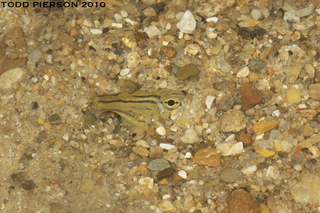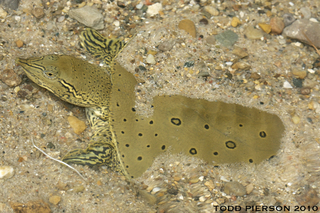It appears the desert of northern Hampshire County may get some precipitation from this storm afterall.
Wood House Research Farm / South Branch Consortium Weather
NOAA Rader Loop (left-click to zoom)
http://radar.weather.gov/radar.php?rid=LWX&product=NCR&overlay=11101111&loop=yes
Observing and reporting the phenology along the South Branch of the Potomac in Hampshire County, West Virginia.
Saturday, August 27, 2011
Monday, August 8, 2011
Cotton, Peanuts and Naked Ladies
 |
| Click here for interactive map |
I was surprised by the bare soil surrounding the cotton, which suggests high herbicide use. I learned that cotton growers also employ an exfoliant toward the end of the growing season, and that enables easier collection of the cotton.
 |
| Cotton field near Suffolk, VA |
I learned a lot about peanuts too, and have been thinking about how they'd do in the alluvial flood plain soil along the South Branch that is an unusual mix of sandy clay. Most sources say sand is good, clay is not. That sounds like an experiment to me.
The Swamp
 |
| Great Dismal Swamp boardwalk |
 |
| Bike trail in the Great Dismal Swamp |
Read more about the Great Dismal Swamp here.
Naked Ladies
When I returned to Hampshire County I saw Naked Ladies everywhere. Their scientific name is Amaryllis belladonna, and they're native to South Africa. I have a few dozen thanks to my neighbor Puddy in the city, who regularly rewards me with neighborliness when thinning her garden.
 |
| Amarylis surround my farm equipment. |
Naked ladies are also known as Belledonna lilies, and they have been popular with gardeners since the late 1700's because of their habit of producing leaves in fall or wet springs, then remaining dormant until now and suddenly sprouting a single stem with an attractive flower. I like them because they are toxic to deer and groundhogs.
Experiments in Hibiscus Propagation
I've had lots of disappointments in propagating local and historically indigenous rose mallows (Hibiscus spp.) They were the first plants in pre-colonial America to be cultivated for shipment back to Europe. The seeds we've collected from locally growing Hibiscus moscheutos (white/cream-colored flowers the size of dinner plates) are always infested with mites that are not killed by freezing.
 We ordered seeds of Hibiscus moscheutos, Hibiscus laevis (syn. militaris), and a subspecies of H. moscheutos often called H. paulstris (actually Hibiscus moscheutos palustris, Swamp Rose Mallow) from Prairie Moon Nursery. We direct-sewed them naturally (as if they'd fallen from the plant's seed pod), and then spent many, many hours trying more advantageous seedings. We've truly only been regularly successful when sewing the seeds in April in the greenhouse and then transplanting after germination (about 100x more work than our preferred approach!).
We ordered seeds of Hibiscus moscheutos, Hibiscus laevis (syn. militaris), and a subspecies of H. moscheutos often called H. paulstris (actually Hibiscus moscheutos palustris, Swamp Rose Mallow) from Prairie Moon Nursery. We direct-sewed them naturally (as if they'd fallen from the plant's seed pod), and then spent many, many hours trying more advantageous seedings. We've truly only been regularly successful when sewing the seeds in April in the greenhouse and then transplanting after germination (about 100x more work than our preferred approach!).
 So now I'm convinced the only strategy for sewing seeds directly is to do so in situ after the last frost, in areas with appropriate moisture, That's not easy, as that is our wettest time of year, and if you observe native H. moscheutos you'll see they grow immediately next to but not in the water.
So now I'm convinced the only strategy for sewing seeds directly is to do so in situ after the last frost, in areas with appropriate moisture, That's not easy, as that is our wettest time of year, and if you observe native H. moscheutos you'll see they grow immediately next to but not in the water.
That said, when the experiments are successful, the colors are impressive. We fence anything (everything!) we transplant. Hibiscus generally survive deer well, but as many of you know, deer usually don't know they don't like something without trying it at least once!
I don't know who this kid is, but I wanted to provide an example of the size of these flowers.
 We ordered seeds of Hibiscus moscheutos, Hibiscus laevis (syn. militaris), and a subspecies of H. moscheutos often called H. paulstris (actually Hibiscus moscheutos palustris, Swamp Rose Mallow) from Prairie Moon Nursery. We direct-sewed them naturally (as if they'd fallen from the plant's seed pod), and then spent many, many hours trying more advantageous seedings. We've truly only been regularly successful when sewing the seeds in April in the greenhouse and then transplanting after germination (about 100x more work than our preferred approach!).
We ordered seeds of Hibiscus moscheutos, Hibiscus laevis (syn. militaris), and a subspecies of H. moscheutos often called H. paulstris (actually Hibiscus moscheutos palustris, Swamp Rose Mallow) from Prairie Moon Nursery. We direct-sewed them naturally (as if they'd fallen from the plant's seed pod), and then spent many, many hours trying more advantageous seedings. We've truly only been regularly successful when sewing the seeds in April in the greenhouse and then transplanting after germination (about 100x more work than our preferred approach!). So now I'm convinced the only strategy for sewing seeds directly is to do so in situ after the last frost, in areas with appropriate moisture, That's not easy, as that is our wettest time of year, and if you observe native H. moscheutos you'll see they grow immediately next to but not in the water.
So now I'm convinced the only strategy for sewing seeds directly is to do so in situ after the last frost, in areas with appropriate moisture, That's not easy, as that is our wettest time of year, and if you observe native H. moscheutos you'll see they grow immediately next to but not in the water. That said, when the experiments are successful, the colors are impressive. We fence anything (everything!) we transplant. Hibiscus generally survive deer well, but as many of you know, deer usually don't know they don't like something without trying it at least once!
 |
| from http://www.visoflora.com/# |
Sunday, August 7, 2011
Growing Citrus in the Eastern Alleghenies
I'm curious to know what cycles others in Hampshire, Morgan, Mineral and Hardy Counties have witnessed in growing lemons, limes and other citrus. The folks at Nature's Art in Cumberland (a very pleasant, easy place to spend money) started me growing lemons and limes last year. Most start producing fruit in April and May indoors. We move them outside after mid-May (about 10-14 days after the predicted last frost). Yesterday one of the limes produced a new flower, even with nearly mature limes already present.
 |
| (click for a larger view) |
Saturday, August 6, 2011
Rain barrels and rain chains
After the rains over the last 10 days, I'm convinced that rain chains simply won't work with typical rain barrel setups. The rain chains are aesthetically pleasing, and they disperse the water in a way that doesn't cause erosion, but the water is broadcast too widely, even if your rain barrel is topped and surround with plants all around.
While it's easy to drain the water on top, it's difficult to screen that water, which is typically filled with small leaves and other things that will clog spigots, valves and our sprinkler and soaker hoses.
While it's easy to drain the water on top, it's difficult to screen that water, which is typically filled with small leaves and other things that will clog spigots, valves and our sprinkler and soaker hoses.
 |
| My rain barrels fed (poorly) by rain chains. |
Tuesday, August 2, 2011
Spiny Softshells of the Ohio River Watershed
 While geocaching on July 12, Stephanie and Rachel found this softshell below one of the Cedar Lakes dam's spillway after a rain. I worried that it would be in danger as the grass dried in the 35oC temperature (and as the grounds crew began mowing), so Rachel placed it back in an aquatic environment.
While geocaching on July 12, Stephanie and Rachel found this softshell below one of the Cedar Lakes dam's spillway after a rain. I worried that it would be in danger as the grass dried in the 35oC temperature (and as the grounds crew began mowing), so Rachel placed it back in an aquatic environment. On July 15 we found an even smaller softshell in the recently mowed grass heading uphill and across the road to one of the lakes. I made the decision to accelerate it's journey because of the roadway. The lake had a few very large snapping turtles - we noticed a few geese with missing feet and broken legs - but the lake certainly seemed safer for an aquatic turtle than a road.
On July 15 we found an even smaller softshell in the recently mowed grass heading uphill and across the road to one of the lakes. I made the decision to accelerate it's journey because of the roadway. The lake had a few very large snapping turtles - we noticed a few geese with missing feet and broken legs - but the lake certainly seemed safer for an aquatic turtle than a road. During college I worked with Florida Soft-shelled Turtles at ZooAmerica, and apparently the Eastern Spiny Softshell is just as fast, and similarly aggressive as a hunter. Its shell is smooth except for the small spines on the front of it's shell that give it's name. The spots also seem to distinguish it from the smooth softshell also found in parts of the Ohio river watershed.
It is primarily a river turtle, and it likes to bury itself in the sand or sandy gravel or mud of river bottoms with only it's snout visible (see photos below).
Most interesting to me is that it can get oxygen from the water. Its embryonic pharyngeal gill slits (which all vertebrates have) become a highly vascular pharynx with a lining thin enough to remove oxygen from the water. I haven't found a diagram or image of this yet. If you find one, add a link in the comments below.
Like other aquatic turtles, it buries its eggs on river banks exposed to the sun; but unlike other turtles, the egg development is not temperature dependent.
Great aquarium photos of A. spinifera burying itself:
 | |
Subscribe to:
Posts (Atom)

